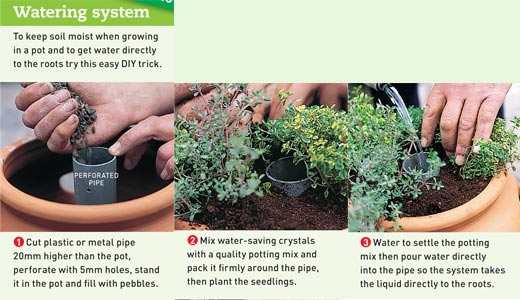
Don’t give up on growing your own produce because you don’t have space. As long as there’s a spot for a container that gets between four and six hours of sun a day, you can reap what you sow.
Combine herbs and vegies in one pot for a productive addition to the balcony. Positioning compatible crops side by side stimulates growth and repels diseases and bugs.
Choosing the Containers
The container type should depend on where it’s positioned. A concrete pot fi lled with potting mix is too heavy to attach to a wall, while terracotta pots tend to leach water and chip easily.
Dark-coloured pots absorb heat that can damage the roots of some plants so consider painting the container or shading it.
Check the depth of the pot
The size of the container is also determined by what you want to grow. Provide enough growing room for the plants to reach maturity, allowing space for roots.
Generally the larger the container the better, providing there’s suffi cient structure underneath to support its weight when filled.
Cultivating a herb garden
Herbs are satisfying to grow and buying seedlings in pots is the simplest way to get the garden started.
Choose healthy looking, vibrantly coloured specimens, checking the underside of mint and marjoram leaves for orange spots that signal a disease called rust. Use an organic mulch over the surface to reduce the need for watering.
Growing a Vertical Garden
Vertical gardens are a way to grow food in compact spaces, making it easier to care for plants and harvest container-grown crops. Using wall space also decorates outdoor areas.
Attach wires to the wall or use a panel of lattice to train climbing plants such as peas, beans, tomatoes and passionfruit.

Selecting the potting mix
You get what you pay for so choose quality mix. Container gardens need soil that drains well but doesn’t dry out rapidly. Soil from the garden compacts quickly but the ingredients in a potting mix keep the soil aerated.
Commercial mixes are guaranteed to be free of plant diseases and weed seeds, and tend to hold moisture and plant nutrients. They’re also lighter in weight than garden soil, making containers more portable.
Potting in containers
Most containers have drainage holes but make some yourself if they don’t. Cover the holes with shadecloth or hessian so moisture drains but soil is not lost when the plant is watered.
Add the potting mix and firm it down then sow seeds or plant seedlings, being careful not to damage delicate shoots or roots.
Leave a space between the soil and top of the pot so water doesn’t fl ow over the edge, then cover with an organic mulch such as sugarcane or tea tree to retain moisture.
Fertilising and watering
Potted plants need regular watering and fertilising as they rely on what they’re given, unlike garden-bed plants that can spread roots to look for water and nutrients.
Watering Poke a finger into the pot to check how damp it is, making sure it never completely dries out. Water daily in summer but don’t overdo it as this fl oods the plant and washes away nutrients.
Fertilising If the plant begins to look depleted add water-soluble fertiliser. Fertilise green leafy vegies every week and other varieties every two to three weeks. Apply quality slow-release fertiliser once a year to keep the soil nutrient rich.
Control pests organically
Watch out for pests enjoying your crop before you do. Mix two cups of vegetable oil and half a cup of pure liquid soap to make a natural pest spray. Dilute a tablespoon of the mix in a litre of water in a spray bottle and spray the plants fi rst thing in the morning in warmer weather.
Room to move
Pots need to be at least this tall for healthy root growth.
- Most herbs 200mm
- Spring onion 200mm
- Radish 200mm
- Asian greens 200mm
- Celery 200mm
- Carrot, baby 250mm
- Most lettuce 250mm
- Capsicum 250mm
- Tomatoes 300mm
- Parsnip 300mm







